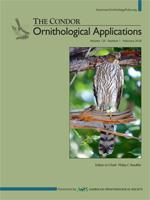The “umbrella species” concept is a conservation strategy in which creating and managing reserve areas to meet the needs of one species is thought to benefit other species indirectly. Broad-scale habitat protections on behalf of an umbrella species are assumed to benefit co-occurring taxa, but targeted management actions to improve local habitat suitability for the umbrella species may produce unintended effects on other species. Our objective was to quantify the effects of a common habitat treatment (mowing of big sagebrush [Artemisia tridentata]) intended to benefit a high-profile umbrella species (Greater Sage-Grouse [Centrocercus urophasianus]) on 3 sympatric songbird species of concern. We used a before–after control-impact experimental design spanning 3 yr in Wyoming, USA, to quantify the effect of mowing on the abundance, nest-site selection, nestling condition, and nest survival of 2 sagebrush-obligate songbirds (Brewer's Sparrow [Spizella breweri] and Sage Thrasher [Oreoscoptes montanus]) and one open-habitat generalist songbird (Vesper Sparrow [Pooecetes gramineus]). Mowing was associated with lower abundance of Brewer's Sparrows and Sage Thrashers but higher abundance of Vesper Sparrows. We found no Brewer's Sparrows or Sage Thrashers nesting in the mowed footprint posttreatment, which suggests complete loss of nesting habitat for these species. Mowing was associated with higher nestling condition and nest survival for Vesper Sparrows but not for the sagebrush-obligate species. Management prescriptions that remove woody biomass within a mosaic of intact habitat may be tolerated by sagebrush-obligate songbirds but are likely more beneficial for open-habitat generalist species. By definition, umbrella species conservation entails habitat protections at broad spatial scales. We caution that habitat manipulations to benefit Greater Sage-Grouse could negatively affect nontarget species of conservation concern if implemented across large spatial extents.
How to translate text using browser tools
2 May 2018
Nontarget effects on songbirds from habitat manipulation for Greater Sage-Grouse: Implications for the umbrella species concept
Jason D. Carlisle,
Anna D. Chalfoun,
Kurt T. Smith,
Jeffrey L. Beck

The Condor
Vol. 120 • No. 2
May 2018
Vol. 120 • No. 2
May 2018
greater sage-grouse
habitat management
mowing
nontarget effects
sagebrush songbirds
surrogate species
umbrella species




